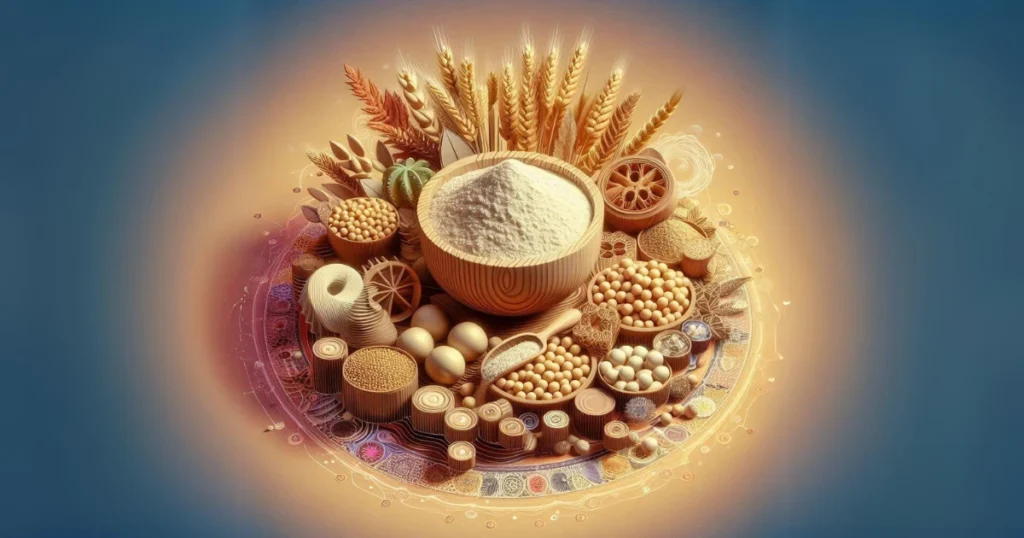
Chickpea flour, commonly referred to as gram, besan, or garbanzo bean flour, has been an essential ingredient in Indian cuisine for many centuries. Derived from Bengal grams, a particular variety of chickpea, this flour exhibits a mild, nutty flavor and is adaptable for various culinary purposes. People worldwide have recently recognized it as a popular gluten-free substitute for wheat flour, and you can easily prepare it at home. Below are seven advantages of incorporating chickpea flour into your diet.
1. Rich in vitamins and minerals
Chickpea flour is rich in essential nutrients.
A single cup (92 grams) of chickpea flour provides.
- Calories: 356
- Protein: 20 grams
- Fat: 6 grams
- Carbs: 53 grams
- Fiber: 10 grams
- Thiamine: 30% of the
Reference Daily Intake (RDI) - Folate: 101% of the RDI
- Iron: 25% of the RDI
- Phosphorus: 29% of the RDI
- Magnesium: 38% of the RDI
- Copper: 42% of the RDI
- Manganese: 74% of the RDI
One cup (92 grams) of chickpea flour contains a slightly greater amount of folate than the daily requirement. This vitamin is vital for the prevention of spinal cord defects during pregnancy.
An observational study with more than 16,000 women revealed that infants born to those who consumed flour enriched with extra folate and other vitamins had a 68% lower incidence of spinal cord defects compared to those born to women who consumed standard flour.
Moreover, the women who opted for fortified flour had blood folate levels that were 26% higher than those in the control group.
Chickpea flour is noteworthy for containing nearly twice the folate of an equivalent serving of fortified wheat flour. It is also a rich source of several essential minerals, including iron, magnesium, phosphorus, copper, and manganese.
2. Packed with fiber
Chickpea flour is rich in fiber, reflecting the naturally high fiber content of chickpeas themselves.
One cup (92 grams) of chickpea flour contains roughly 10 grams of fiber, which is threefold the fiber content of white flour.
People recognize fiber for its numerous health benefits, and studies have associated the fiber obtained from chickpeas with improvements in blood lipid profiles.
In a 12-week study involving 45 participants, the consumption of four 10.5-ounce (300-gram) cans of chickpeas weekly, without altering other dietary habits, resulted in a reduction of total cholesterol levels by 15.8 mg/dl. This outcome is likely due to the fiber present in chickpeas.
Another study with 47 participants demonstrated that a five-week diet including chickpeas led to a 3.9% decrease in total cholesterol and a 4.6% reduction in LDL (bad) cholesterol in comparison to a diet based on wheat.
Additionally, chickpeas are a source of resistant starch, a specific type of fiber. A study assessing the resistant starch levels in various foods found that roasted chickpeas ranked among the top two, alongside unripe bananas.
Studies indicate that chickpeas may contain as much as 30% resistant starch, contingent upon their processing methods. An examination revealed that chickpea flour derived from precooked chickpeas had a resistant starch content of 4.4%.
This type of starch remains undigested until it reaches the large intestine, where it provides nourishment for healthy gut bacteria. Its consumption has been associated with a lower risk of various health issues, such as heart disease, type 2 diabetes, and colon cancer.
3. Substitute for wheat flour
Chickpea flour effectively substitutes wheat flour.
It offers a more advantageous nutrient profile than refined flour, delivering increased levels of vitamins, minerals, fiber, and protein, along with reduced calories and carbohydrates. Its absence of wheat makes it suitable for those with celiac disease, gluten intolerance, or wheat allergies.
Nevertheless, individuals concerned about cross-contamination should opt for certified gluten-free varieties.
Additionally, chickpea flour behaves similarly to refined flour in various fried and baked applications. Its dense nature partially imitates the role of gluten in wheat flour, providing structure and chewiness when cooked.
Research aimed at creating a gluten-free bread indicated that a blend of three parts chickpea flour and one part potato or cassava starch was optimal, although using only chickpea flour also produced an acceptable outcome.
Moreover, incorporating chickpea flour to replace 30% of wheat flour in cookie recipes significantly increased the nutrient and protein levels while maintaining a pleasing taste and appearance.
4. Fewer calories than regular flour
Chickpea flour serves as an excellent substitute for wheat flour for individuals aiming to lower their calorie consumption. When compared to an equivalent serving of refined wheat flour, one cup (92 grams) of chickpea flour contains approximately 25% fewer calories, indicating that it is less energy-dense.
Researchers have thoroughly studied the concepts of energy density and portion size in relation to weight management.
Experts suggest that maintaining familiar portion sizes while opting for foods with lower calorie content is a more effective approach to weight loss than merely reducing food intake.
In a 12-week randomized study involving 44 overweight participants, those who incorporated more lower-calorie foods lost 4–8 pounds (1.8–3.6 kg) more than those who followed more complicated dietary guidelines.
5. Affects blood sugar less
Chickpea flour is characterized by having roughly half the carbohydrate content of white flour, which may influence blood sugar levels differently. The Glycemic Index (GI) quantifies the speed at which a food converts into sugars, potentially causing an increase in blood sugar.
Glucose, the primary energy source for the body, has a GI of 100, indicating it elevates blood sugar levels rapidly. In comparison, white flour has a GI of around 70.
Chickpeas have a GI of 6, while experts estimate that snacks made from chickpea flour have a GI ranging from 28 to 35. These low-GI foods are likely to produce a more gradual increase in blood sugar compared to white flour.
Two observational studies involving 23 participants found that consuming foods made with chickpea flour resulted in lower blood sugar levels compared to those made with white or whole-wheat flour.
Additionally, a study involving 12 healthy women revealed that whole-wheat bread containing 25–35% chickpea flour had a significantly lesser effect on blood sugar than both white bread and 100% whole-wheat bread.
Nevertheless, further and larger studies are necessary to explore the connection between chickpea flour and blood sugar levels.
6. Higher in protein than other flours
Chickpea flour contains a higher protein content compared to other types of flour, such as white and whole-wheat flour.
A single serving of 1 cup (92 grams) of chickpea flour delivers 20 grams of protein, whereas white flour offers 13 grams and whole-wheat flour provides 16 grams. Protein is essential for muscle development and recovery from injuries and illnesses, and it also plays a significant role in managing body weight.
Foods rich in protein promote a feeling of fullness for an extended period, and the body expends more calories during the digestion of these foods.
Additionally, sufficient protein intake is crucial for maintaining lean muscle mass, particularly during weight loss. Chickpeas serve as an excellent protein source for vegetarians and vegans, as they provide 8 of the 9 essential amino acids necessary for a balanced diet.
Other plant-based foods, such as baby lima beans, abundantly contain the remaining essential amino acid, methionine.
7. Reduce the formation of harmful compounds in processed foods
Chickpeas are rich in beneficial antioxidants known as polyphenols.
Antioxidants are substances that combat unstable molecules referred to as free radicals within the body, which are believed to play a role in the onset of various diseases.
Research indicates that plant-derived polyphenols can effectively reduce free radicals in food and mitigate some of the damage they may inflict on the body.
Moreover, chickpea flour is currently under investigation for its potential to lower the acrylamide levels found in processed foods.
Food processing generates acrylamide, an unstable byproduct, which is often present in significant quantities in snacks made from flour and potatoes.
This compound is considered potentially carcinogenic and has been associated with reproductive issues, as well as impairments in nerve and muscle function, along with disruptions in enzyme and hormone activity.
In a comparative study of various flours, researchers found that chickpea flour yields one of the lowest levels of acrylamide when subjected to heat.
Additionally, researchers discovered that applying chickpea batter to potato chips resulted in reduced acrylamide formation compared to chips treated with antioxidants derived from oregano and cranberry.
Lastly, another study revealed that shortbread cookies made with a combination of wheat and chickpea flour contained 86% less acrylamide than those made solely with wheat flour.
The bottom line
Chickpea flour is abundant in beneficial nutrients, making it an excellent substitute for refined wheat flour. It contains fewer carbohydrates and calories while offering a higher content of protein and fiber.
Studies indicate that chickpea flour may possess antioxidant properties and has the potential to reduce the presence of the harmful compound acrylamide in processed foods.
Its culinary characteristics are comparable to those of wheat flour, rendering it suitable for individuals with celiac disease, gluten intolerance, or wheat allergies.
Incorporating chickpea flour into your diet is a flavorful and nutritious choice that can enhance your overall health. You can find it with ease in shops and online platforms, and it is also straightforward to prepare at home.


